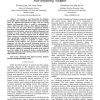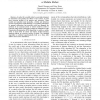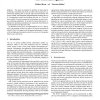271 search results - page 12 / 55 » Bio-inspired Model of Robot Adaptive Learning and Mapping |
IROS
2006
IEEE
14 years 2 months ago
2006
IEEE
— This paper presents an adaptive causal model method (adaptive CMM) for fault diagnosis and recovery in complex multi-robot teams. We claim that a causal model approach is effec...
IROS
2006
IEEE
14 years 2 months ago
2006
IEEE
- We propose a novel framework for imitation learning that helps a humanoid robot achieve its goal of learning. There are apparent discrepancies in shapes and sizes among humans an...
TROB
2011
13 years 2 months ago
2011
— This paper defines and analyzes a simple robot with local sensors that moves in an unknown polygonal environment. The robot can execute wall-following motions and can traverse...
ICRA
2008
IEEE
14 years 2 months ago
2008
IEEE
— In order for a mobile robot to accurately interpret its sensations and predict the effects of its actions, it must have accurate models of its sensors and actuators. These mode...
ECAI
2000
Springer
14 years 9 days ago
2000
Springer
This paper investigates the problem of improving the performance of general state-of-the-art robot control systems by autonomously adapting them to specific tasks and environments...



